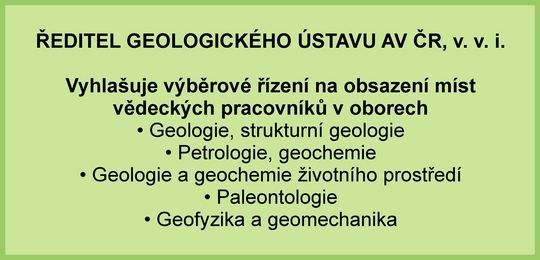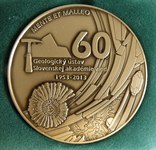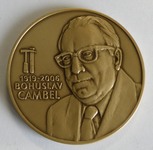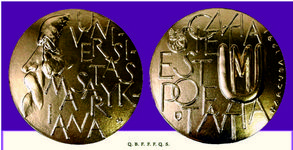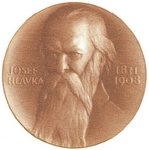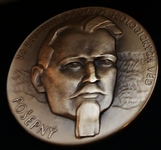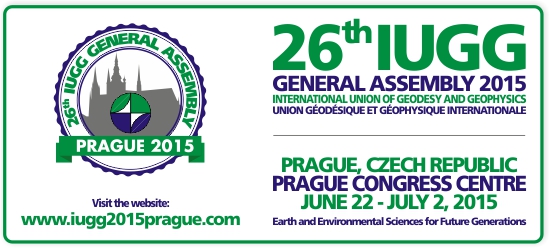Institute of Geology AS CR, v. v. i.
Medium-sized research center which main purpose is to gain, interpret and integrate the knowledge of the Earth System.
News
Visit of Professor Paul Williams from the University of Auckland, New Zealand
On September 12, 2014, the Institute of Geology AS CR was visited by Paul Williams, Emeritus Professor of University of Auckland, New Zealand. Prof. Williams specializes in the dating of Quaternary sediments and cave speleothems. His visit, organized by the Bohemian Switzerland National Park Administration, included discussions of geological and geomorphological history of sandstone areas of the Bohemian Cretaceous Basin, most notably that of the Elbe Sandstones area. (Photos by Pavel Lisý)

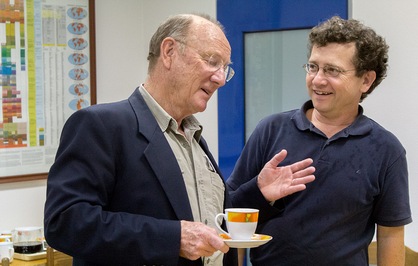
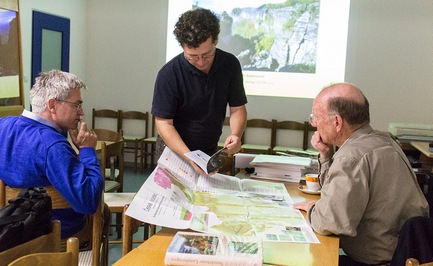
Matters of interest
Cryogenic cave carbonates – a new tool to estimate the minimum permafrost depth of the Last Glacial
Cryogenic cave carbonates can be identified in caves based on their characteristic mode of occurrence, typical shape, unique carbon and oxygen stable isotope compositions, and based on ages confirming their formation during the Glacial. Low-ventilation caves generally show temperature close to those of the surrounding rock. Cooling of such caves to freezing and/or subfreezing temperature is possible only due to evolution of permafrost (permafrost is the zone of soils and rocks having temperature 0 °C or lower for at least two subsequent years).
Ichnofossils associated with slightly skeletonized body fossils, Middle Cambrian of the Barrandian area, Czech Republic
Sediments of the Middle Cambrian of the Barrandian area yielded several distinct morphotypes of ichnofossils preserved in a tight association with non- or slightly-mineralized animal body fossils, most often arthropods. These traces, in lesser diversity, were described from the Cambrian of the Barrandian area already in 2000 by the present author. Later, since 2006, analogous trace fossils have been described from classical Cambrian lagerstätten, namely Chengjiang and Burgess.
Mineral inclusions in placer zircon from the Ohře (Eger) Graben: New data on „strontiopyrochlore“
After qualitative examination of the inclusion inventory of 80 zircon megacrysts from alluvial placers of the Cenozoic alkali basalt area of northern Bohemia and southeastern Saxony, three representative megacrysts from the Podsedice deposit were selected for an in-depth study of inclusion minerals. Primary and secondary inclusions were distinguished and used as monitor for zircon-related syn- and epigenetic processes.
Interpretation of the Teplice Caldera history based on the LA-ICP-MS study of quartz crystal zoning
The Altenberg–Teplice Caldera (eastern Krušné Hory/Erzebirge) is the largest Variscan volcano-plutonic complex in the Bohemian Massif. It is composed of co-magmatic volcanics (peraluminous basal rhyolite and associated dacite, overlying three units of subaluminous Teplice rhyolite and granite porphyry) and plutonic granites (two intrusions of A-type granites). In this study, the internal structures and trace-element distributions within quartz grains were investigated using a laser ablation ICP-MS combined with a hot-cathode and scanning cathodoluminescence analysis.
Kozlowskii Event: mass faunal extinction and global environmental perturbations recorded in the upper Silurian succession of the Prague Synform.
Ladislav Slavík, Petr Štorch
About Institute
 Institute of Geology AS CR, v. v. i. is a medium-sized research center which main purpose is to gain, interpret and integrate the knowledge of the Earth System and its geologic and biologic past, without which it would not be possible to understand the recent environment. The Earth system understood as a result of interaction of endogenous and exogenous geological processes, development of biota and anthropogenic effects. Co-evolution of the Earth system means close connection and constant mutual influence of biotic and abiotic processes resulting in changes of atmosphere composition, climatic changes and weathering rates, relief development, sedimentary basin development and genesis of some types of natural resource bearings.
Institute of Geology AS CR, v. v. i. is a medium-sized research center which main purpose is to gain, interpret and integrate the knowledge of the Earth System and its geologic and biologic past, without which it would not be possible to understand the recent environment. The Earth system understood as a result of interaction of endogenous and exogenous geological processes, development of biota and anthropogenic effects. Co-evolution of the Earth system means close connection and constant mutual influence of biotic and abiotic processes resulting in changes of atmosphere composition, climatic changes and weathering rates, relief development, sedimentary basin development and genesis of some types of natural resource bearings.


